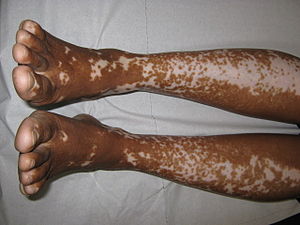
Despite years of research, Vitiligo is still an enigma. Vitiligo could well be the most “serious” cosmetic disorder of the skin, in terms of the psychological morbidity it causes especially on pigmented skin. Even now we are not sure whether vitiligo is autoimmune, genetic, oxidative stress, neural, viral or a combination of all the above. Treatment of vitiligo, just like fashion, keeps changing the favourite, every now and then. Immunosuppressants had their time. Phototherapy was a clear favourite before the reign of melanocyte transplant began.
Let us hope that this heat shock protein successfully negotiates the long gap between mice and humans. Hope the vaccine will not ‘shock’ us by degenerating into another ‘hot’ fashion. I shall soon discuss the latest trends in vitiligo genomics in my informatics blog. Meanwhile take a look at this new concept of ‘Vitiligo Potential Repigmentation Index’.[2]All these years vitiligo was never viewed as a preventable disease. Though it is still early days, latest genomic techniques are suggesting that vitiligo is a genomic vaccine preventable condition! The vaccine could also improve established cases of vitiligo. A chaperone (molecules assisting the folding process of proteins) called heat shock protein 70 (HSP70) is implicated in the pathogenesis of vitiligo. A genetically modified HSP70 when administered as a vaccine prevented and cured vitiligo in mice.[1]
A recent study showed that a combination of afamelanotide implant and NB-UV-B phototherapy resulted in clinically apparent, statistically significant superior and faster repigmentation compared with NB-UV-B monotherapy. The response was more noticeable in patients with SPTs IV to VI.[3]
References:
1. “Mutant Heat Shock Protein Vaccine Prevents Vitiligo in Mouse Model.” 2013. 31 Mar. 2013: Click here
2. Benzekri, L., Ezzedine, K. and Gauthier, Y. (2013), Vitiligo Potential Repigmentation Index: a simple clinical score that might predict the ability of vitiligo lesions to repigment under therapy. British Journal of Dermatology. doi: 10.1111/bjd.1
3. Lim HW, Grimes PE, Agbai O, Hamzavi I, Henderson M, Haddican M, Linkner RV, Lebwohl M. Afamelanotide and Narrowband UV-B Phototherapy for the Treatment of Vitiligo: A Randomized Multicenter Trial. JAMA Dermatol. 2014 Sep 17. doi: 10.1001/jamadermatol.2014.1875. [Epub ahead of print] PubMed PMID: 25230094.
- Machine learning-based BOTOX API - April 11, 2023
- Skinmesh: Machine learning for facial analysis - November 10, 2020
- Free Dermatology EMR for Machine Learning and Artificial Intelligence - January 2, 2020
Inhibition by luteolin of IL-8 release could be useful for vitiligo therapy. http://tinyurl.com/lqkbaf9 via @beapen
Miniati, A., Weng, Z., Zhang, B., Therianou, A., Vasiadi, M., Nicolaidou, E., Stratigos, A. J., Antoniou, C. and Theoharides, T. C. (2013), Stimulated human melanocytes express and release interleukin-8, which is inhibited by luteolin: relevance to early vitiligo. Clinical and Experimental Dermatology. doi: 10.1111/ced.12164